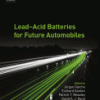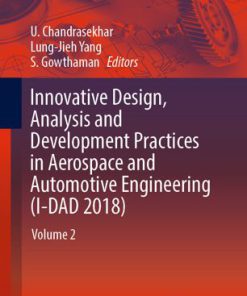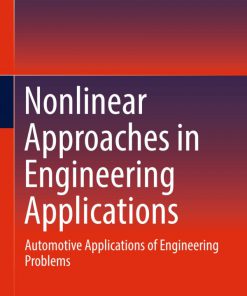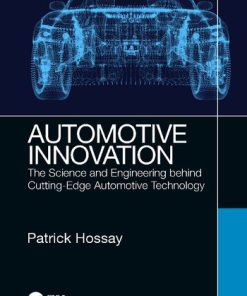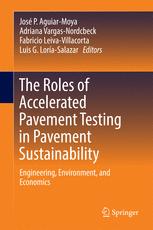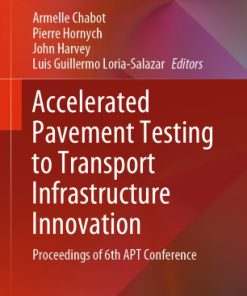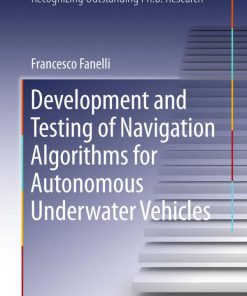Trends in Development of Accelerated Testing for Automotive and Aerospace Engineering 1st Edition by Lev Klyatis 0128188422 9780128188422
$50.00 Original price was: $50.00.$25.00Current price is: $25.00.
Trends in Development of Accelerated Testing for Automotive and Aerospace Engineering 1st Edition by Lev M. Klyatis – Ebook PDF Instant Download/DeliveryISBN: 0128188422, 9780128188422
Full download Trends in Development of Accelerated Testing for Automotive and Aerospace Engineering 1st Edition after payment.
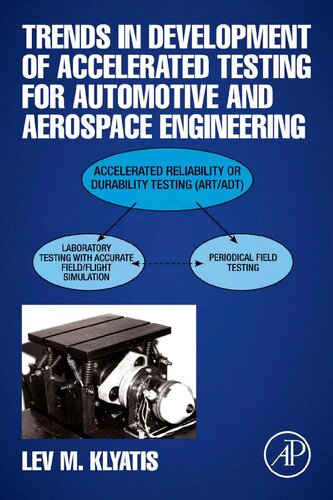
Product details:
ISBN-10 : 0128188422
ISBN-13 : 9780128188422
Author: Lev M. Klyatis
Accelerated testing (most types of laboratory testing, proving ground testing, intensive field/flight testing, any experimental research) is increasingly a key component for predicting of product’s/process performance.
Trends in Development Accelerated Testing for Automotive and Aerospace Engineering provides a completely updated analysis of the current status of accelerated testing, including the basic general directions of testing (methods and equipment) development, how one needs to study real world conditions for their accurate simulation and successful accelerated testing, describes in details the role of accurate simulation in the development of automotive and aerospace engineering, shows that failures are most often found in the interconnections, step-by-step instructions and examples. This is the only book presently available that considers in detail both the positive and negative trends in testing development for prediction quality, reliability, safety, durability, maintainability, supportability, profit, and decreasing life-cycle cost, recalls, complaints and other performance components of the product. The author presents new ideas and offers a unique strategic approach to obtaining solutions which were not possible using earlier. His methodology has been widely implemented, continue to be adopted throughout the world, and leads to advance society through product improvement that can reduce loss of life, injuries, financial losses, and product recalls.
Trends in Development of Accelerated Testing for Automotive and Aerospace Engineering 1st Table of contents:
1 – Terms and definitions
Correct terms and definitions
References
2 – Analysis of the current status of accelerated testing
2.1 Introduction
2.1.1 International standard in accelerated testing
2.1.2 Recalls as source material for providing official information about product defects
2.2 Basic general directions of accelerated testing development
2.2.1 The first general direction (field/flight accelerated testing)
2.2.2 The second general direction (accelerated testing based on computer/software simulation)
Computer simulation and statistical analysis
Computer simulation software
Statistical analysis software
Commonly used databases
Computer-based simulations
Vehicle and driver-vehicle software simulations
Human response, control modeling, and simulation applications
Extensive aerospace applications experience
2.2.3 The third general direction (laboratory and proving ground testing with physical simulation of
Historical experience with accelerated test methods
Developing an accelerated testing technology road map
2.2.4 The fourth general direction (accelerated reliability/durability testing)
2.3 Classifications of accelerated testing
2.3.1 Qualitative testing
2.3.2 ESS (Environmental Stress Screening) and burn-in
2.3.3 Quantitative accelerated life testing
Time compression approach
Build a stress to life relationship approach
Given acceleration model approach
Step-stress approach
Shock testing approach
Degradation approach
2.4 Fatigue accelerated testing
2.4.1 Common consideration
Fatigue and structural integrity of aerospace systems
2.4.2 Locati method
2.4.3 Staircase Loreti method
2.4.4 Methods of analysis by numerical simulation
2.4.5 The numerical simulation of the Staircase
2.4.6 The numerical simulation of the Locati
2.4.7 The numerical simulation of the Staircase Locati
2.4.8 Fatigue testing for aircraft and satellites
2.5 Vibration testing
2.6 Crash testing
Risks of Airbag Deployment versus Risk of Injury or Death
Disadvantages of Having Passenger Car Airbags
Potential Injury
Resetting Airbags
Virtual Dummies
Bibliography
Exercises
4 – Basic negative and positive trends in the development of accelerated testing
4.1 Introduction
4.2 Negative trends in the development of accelerated testing
4.2.1 Basic negative trends in the development of accelerated testing
4.2.1.1 Mentality causes
4.2.1.2 Engineering causes
4.2.2 Common negative trends in accelerated testing development related to automotive and aerospace
4.2.3 Specific tactical negative trends in accelerated testing development
4.2.4 Trends in using virtual (computer) simulation and testing as a replacement for field/flight co
4.2.5 Erroneous use of the exponential law of distribution in accelerated testing
Introduction
Analysis of the exponential growth-based models
Events in which there is an exponential law of distribution correlation
Conclusions
4.3 Positive trends in the development of accelerated testing
4.3.1 Common positive trends in accelerated testing development
4.3.1.1 A&D modular test system
4.3.2 Specific positive trends in accelerated testing that relate to any specific type of testing in
4.3.2.1 Positives in reliability testing
4.3.2.2 Positives in vibration testing
Facilities
Surface analysis
Bibliography
Exercises
5 – The role of accurate simulation in the development of accelerated testing in automotive and aero
5.1 Introduction
5.2 The role of accurate engineering simulation in the development of automotive and aircraft system
The evolving role of UAS
Integrated unmanned systems roadmap in 2007 [5.3]Implication for UAS designers and suppliers
The role of engineering simulation
5.3 Establishing the concepts and statistical criteria for providing the physical simulation of the
5.4 Determining the number and types of test parameters for analysis during accelerated reliability
5.5 Improvement in the accelerated testing engineering culture
5.5.1 An organization’s aspects of culture as a component for improving the engineering culture
Bibliography
Exercises
6 – Implementation of basic positive trends in the development of accelerated testing
6.1 Introduction
6.2 Some aspects of implementation of accelerated reliability and durability testing, including cita
6.2.1 Areas of ART/ADT implementation presented by other authors
6.2.2 Examples with some citations from publications other than those published in the book Reliabil
6.3 Some citations from published reviews to this author’s previous books related to the implementat
6.4 Some strategic aspects of the implementation of the positive trends in accelerated testing for s
6.5 Some of the author’s patents in accelerated testing improvement that were actually implemented
6.6 Implementation of the new concepts of accelerated testing improvement
Bibliography
Exercises
7 – Trends in the development of equipment for accelerated testing
7.1 Introduction
7.2 General trends in development testing equipment
7.2.1 Global general trend test equipment market
7.3 Trends in the testing and measurement industry
7.3.1 Transformational shifts ahead. 1.94K
7.3.1.1 Growth prospects and key trends for electronic testing and measurement (T&M) equipment
7.3.2 Testing is more just new equipment
7.3.3 WiseGuy reports forecast “electronic test and measurement market”
7.3.4 Overview of the automotive test equipment market [7.8]7.3.5 Industry/innovation/related news
7.3.6 Automotive test equipment market – segmentation
7.3.7 Automotive test equipment market – regional analysis
7.3.8 A historical perspective of EMC & field strength test solution [7.9]7.3.9 Market size and forecast
7.4 Equipment for aerospace simulation
7.4.1 Aerospace/altitude/space simulation
7.4.2 Standard version
7.4.3 Options
7.4.4 Aerospace materials testing
7.4.5 Fatigue testing capabilities
7.4.6 Abrasion & wear testing
7.4.7 Electrostatic discharge testing
7.4.8 F-gas compliance
7.5 Combined testing equipment
7.5.1 Aerospace testing equipment
7.5.2 Environmental testing and test facilities
7.5.3 ETS mechanical data handling facilities
7.5.4 ETS’s maintenance, management and test facility services
7.5.5 Chambers, enclosures, and test cell product gallery: EMC chambers
7.5.5.1 Free-space Anechoic Chamber Test (FACT)
7.5.6 Statistical mode averaging reverberation chambers (SMART)
7.5.6.1 SMART™ 80
7.5.7 Environmental combined testing equipment for military vehicles
7.5.7.1 Test equipment for commercial vehicles
7.5.8 Refrigeration systems
7.5.9 Other automotive test equipment
7.6 Combined testing for vehicle components
7.6.1 Wheel & hub test systems
7.6.2 Transmission & driveline test systems
7.6.3 AV-series agree vibration chambers. temperature/humidity/vibration chambers
7.6.3.1 CV-series vibration chambers. temperature – humidity – vibration chambers
7.6.3.2 Drive-in chamber features
7.7 Equipment for accelerated reliability and durability testing
Bibliography
Exercises
8 – How to use the positive trends in the development of accelerated testing and avoid the negative
8.1 Introduction
8.2 Analysis of the current situation in accelerated testing
8.3 Adopting the positive trends in accelerated reliability and durability testing technology
8.3.1 Step 1: Collection of the initial information from the field
8.3.2 Step 2: Analysis of the field/flight initial information as a random process
8.3.3 Step 3: Establishing concepts for the physical simulation of the input influences on the produ
8.3.4 Step 4: The development and use of test equipment, which simulates the field/flight input infl
8.3.5 Step 5: Determining the number and types of test parameters for analysis during accelerated re
8.3.6 Step 6: Selecting a representative input region for accelerated reliability testing
8.3.7 Step 7: Preparation procedures for the actual accelerated reliability/durability testing
8.3.8 Step 8: Use statistical criteria for comparing accelerated reliability/durability testing resu
8.3.9 Step 9: Collection, calculation, and statistical analysis of the accelerated reliability/durab
8.3.10 Step 10: Prediction of the dynamics of the test subject’s reliability, durability, and mainta
8.3.11 Step 11: Using accelerated reliability/durability testing results for rapid and cost-effectiv
People also search for Trends in Development of Accelerated Testing for Automotive and Aerospace Engineering 1st:
trends of development in early childhood
trends in development
trends in learning and development
trends in education and training
trends in adult learning
Tags: Trends in Development, Accelerated Testing, Automotive, Aerospace Engineering, Lev Klyatis
You may also like…
Engineering - Engineering - General & Miscellaneous
Engineering - Automotive
Engineering - Automotive
Computers - Programming
Engineering - Civil & Structural Engineering
Uncategorized



